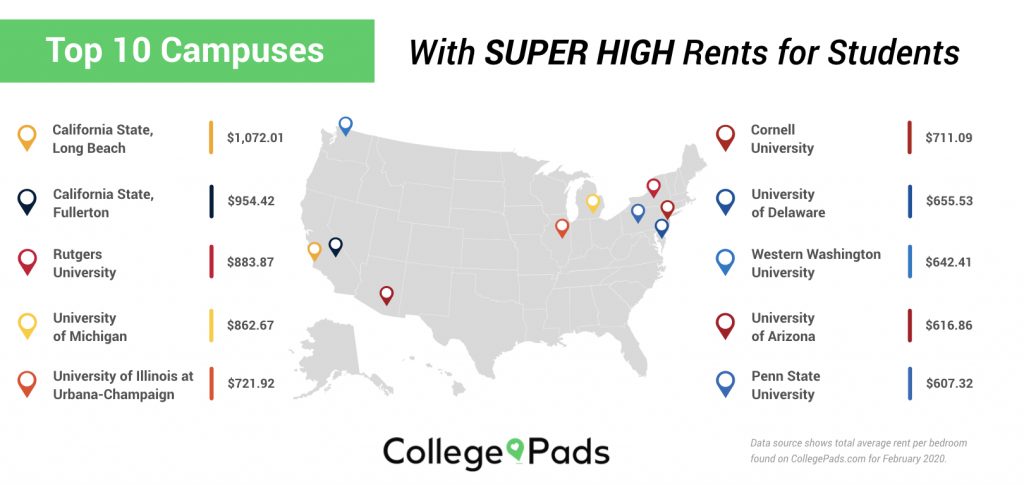
After doing a year or two of hard time in the medium security correctional facility commonly referred to as “on-campus living”, students are itching for the freedom of living off-campus. No rules. No RA’s. No more shuffling down the hall in a towel to your room after a shower. Just freedom. But that freedom comes at a price: Rent.
While living off-campus is traditionally cheaper than living on-campus, that doesn’t mean that by choosing to live off-campus you’ll suddenly be paying thousands less in living expenses and start living like someone from Fancy Living Digest. What it actually means is that you’ll be paying a little less than you would in the dorms, but you’ll have more freedoms (and responsibilities).
Unfortunately for students across the nation, the cost of college is rising 8 times faster than the cost of wages (yikes) which makes paying for rent increasingly more difficult. Sure, there are a ton of ways to make sure you don’t end up having to sell a kidney (or two) to pay for next semester’s rent, like keeping what’s important in mind when you’re looking for your next place – I.e., lazy rivers, 24-hour fitness centers, indoor something-ball courts, and personal masseuses are not necessary amenities to have in your next rental.
However, when you attend any of our 10 campuses with super high rents, you’re going to be stuck.
- California State, Long Beach
- California State, Fullerton
- Rutgers University
- University of Michigan
- University of Illinois at Urbana-Champaign
- Cornell University
- University of Delaware
- Western Washington University
- University of Arizona
- Penn State University
While there are hundreds of different factors leading up to why these schools have the most expensive average rent prices for student renters, the main factors that affect the cost of rent include: Enrollment, Luxury Apartments, School Prestige, and Vacancy Rate. So let’s dive into the reasons why each campus is so expensive.
Enrollment
Post-secondary enrollment across the board has decreased by 1.3% in 2019, a drop of more than 231,000 students from last year … probably due to the increase in the cost of college and the diminishing value of a degree.
But at some schools, like the University of Michigan which enrollment has grown 10.23% and the University of Delaware which enrollment has grown 8.93% in the last 5 years, have grown at a rate that’s outpaced the availability of on-campus and off-campus housing. The principles of supply and demand have led to one thing: expensive places to live.
If you’re looking for apartments near the University of Michigan or UDel off-campus housing, you’re going to get squeezed. It’s the price you’re paying for attending a super strong school that everyone else wants to attend as well.
In markets like these, it’s really the landlord’s game. They know they can charge what they want because the demand for an apartment near campus is high.
Luxury Apartment Complexes
When enrollments were growing and growing and growing and international student numbers were booming, more and more developers began building luxury student apartments at campuses nationwide throughout the 2010s.
The apartments near Rutgers University and University of Illinois at Urbana-Champaign apartments have transitioned from traditional, old-school, regular by the unit rentals to the luxury complexes. Typically the luxury student housing development rent by the room, rather than by the unit. And these developments, with features like swimming pools, tanning salons, study spaces and more, are not cheap.
The more luxury apartments at a campus, the higher the overall per bedroom rent is going to be. Even if rental house prices remain fairly steady, as they have at UIUC. But a lack of space in Collegetown near UIUC has led to more and more students living in higher priced apartments.
School Prestige
We all know college is expensive, but going to a popular or Ivy League university is going to a whole new level of expensive. According to HomeUnion, schools where the cost of education is higher often have higher rent prices. Why? There are a couple of reasons.
Many of these schools are based on the east coast, where real estate is more valuable and the overall cost of living is higher. That’s why apartments near Cornell in Ithaca are much more expensive than around many schools in the midwest.
Near the University of Arizona, where students enjoy beautiful weather and a pool at almost every apartment near U of A, students are willing to pay up to party study.
Penn State University is another school with a lot of history, a lot of demand, and a lot of students living in apartments. It’s the perfect storm for a high cost of living per bedroom (though the students who live in houses near Penn State can pay a bit less on average).
Vacancy Rate
According to the Homeunion, schools in big cities are the most expensive rent wise and for good reason. The bigger the city, the more people there are going to be condensed into that area. Which means that the rental market is going to be extremely competitive for students because they won’t just be competing against other students for housing like they would be in smaller college towns.
But city size isn’t the biggest indicator of expected rent. Vacancy rate can give you a much better idea of if you’ll be paying extra for a place to sleep, study and relax.
When there’s low vacancy rate and a surplus in people in cities within a few miles of a college campus, the rent prices for students are going to be extremely high. You can see this happening when students look for housing near Western Washington (2.59% vacancy rate), apartments near Cal-State Long Beach (3.6% vacancy rate), and apartments near Cal-State Fullerton (2.6% vacancy rate).
As a comparison, keep in mind that the current national rental vacancy is about 7%.
